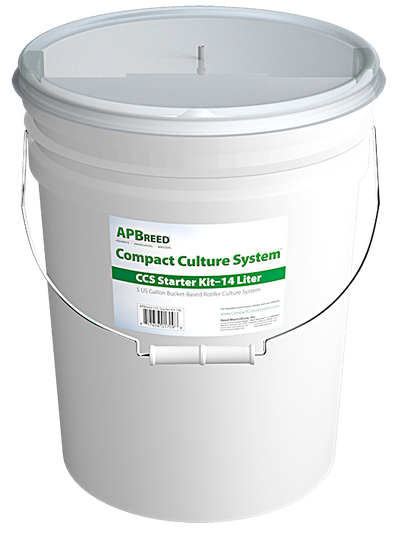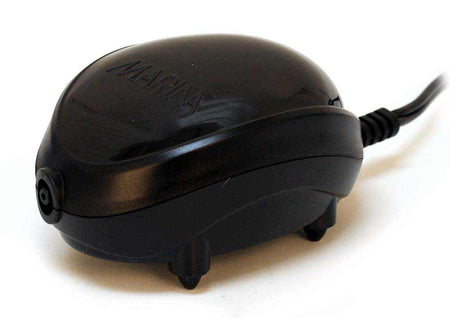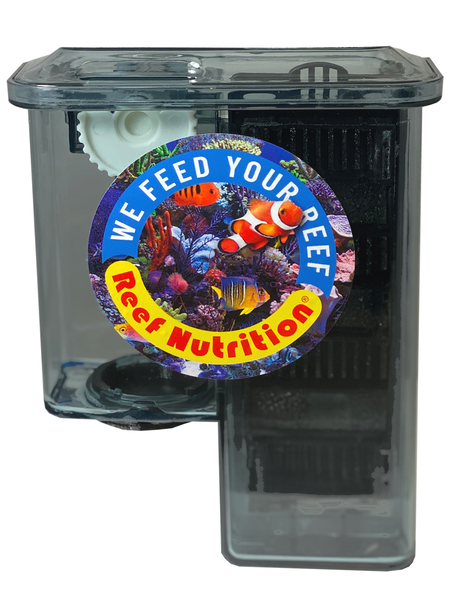
Compact Culture System™
Note: This product is no longer available. Recommended Replacement: Roti-Clean™ Filter. The CCS can still be purchased from Reed Mariculture.
Product Description
Benefits
 Easy to use and maintain
Easy to use and maintain
Daily maintenance of the culture (aside from feeding and harvesting) requires only 5 minutes to flush the waste from the trap and brush the interior surfaces of the bucket.
 Economical
Economical
 Simple, durable design, easily transported
Simple, durable design, easily transported
 Optimized oxygenation, circulation & waste control
Optimized oxygenation, circulation & waste control
 Includes flexible translucent cover that isolates the culture from contamination
Includes flexible translucent cover that isolates the culture from contamination
Product Use
Setup
- Remove Airstone
Pull airstone off the rigid airline.

- Insert Rigid Airline into T-Assembly
Push airline through the hole in the top of the T-fitting.

- Attach Standpipe
Insert top of floss carrier standpipe into T-fitting.

- Re-attach Airstone
Carefully slide airstone on to the end of the rigid airline.

- Attach Clips to Bucket
Insert tab of clip under rim of bucket, swing tab into place against inside of bucket. Attach 2nd clip on opposite side of bucket.

- Fitting T-Assembly into Bucket
Seat one arm of the T into a clip, push while holding onto opposite clip to deform rim of bucket and seat other arm in opposite clip.

- Add 14 Liters Saltwater
Add 14 liters of saltwater, rotifer feed, and rotifer starter culture.

- Attach Air Source to Top of Rigid Airline
Seat bucket cover in place; stretch slightly to fit over clips. Attach tubing from air source to the rigid airline.

Maintenance
- Harvest Culture & Water Change
Once culture reaches desired density, harvest 20-30% each day.

- Clean Rotifer Floss
Deform bucket rim to release T from clips, lift T out of water and let free water drip into bucket. Flush waste from floss with strong spray of water.

- Brush Bucket Surfaces
Brush interior surfaces of the bucket to remove adhering detritus, so it can be trapped and removed by the floss. Replace harvested volume with new saltwater.

- Feed Rotifer Culture
Re-install T into bucket clips, feed culture, re-attach cover, re-attach air supply.

NOTE: After a newly-started culture has been growing for a while, some of products of rotifer metabolism accumulate in the water and result in foam formation. You will also see the water gradually turn brownish, for the same reason. This brown coloration makes is harder to see the green tint from the feed in the water, but you can use the appearance of the foam to judge when the feed is depleted. RGComplete actually has anti-foam properties, and you will see that when you add feed the foam dissipates.
But accumulation of foam doesn’t necessarily mean you need to feed. If you are producing enough rotifers for your needs with a particular feed rate, you don’t need to increase the feed. But the foam does tell you that if you feed at that point, you are not in danger of overfeeding.
Harvesting
Harvesting the Rotifer Culture
- It is best to harvest rotifers every day
- Approximately 30% is a good daily harvest rate
- If one day you need more rotifers, it is OK to harvest more heavily. To increase the number of rotifers harvested every day, increase the feed rate but keep a consistent harvest rate. For fewer rotifers just reduce the feed rate.
- To harvest rotifers, remove the appropriate volume of culture. The rotifers can be concentrated on a screen and collected, or you can simply pour the rotifer culture water into your tank.
- Replenish the rotifer culture with new saltwater.
Counting Rotifers
- Important: Stir culture first to ensure a representative sample
- Pipet a sample (typically 10 mL) into a vial. To immobilize the rotifers for counting, add 5 drops of vinegar and mix.
- Important: Stir sample so it is well-mixed and then quickly — before rotifers have time to settle out — use a pipet to transfer a known volume to a counting slide.
- Count the rotifers in that volume and calculate the number per mL or L.
- Your count should include at least 100 rotifers to be statistically reliable. If it is lower, count additional volumes.
- The most accurate counts are made with a Sedgewick-Rafter type slide that has a grid of 50 x 20 = 1,000 squares. You can count the rotifers in 100 squares and multiply by 10 to get the number of rotifers/mL. If the number is below 100, count more squares; if you count 200 squares, multiply by 5.
Technical Info
CCS Rotifer Culture Specifications
- Air flow: Minimum 1.5 - 2 LPM
- Salinity: 10-35 ppt (S.G. 1.0075 - 1.026), optimum 15-20 ppt
- Temperature: 27°C/80°F (L rotifer type); 30°C/86°F (S rotifer type)
- pH: 7-8 is optimal, 6.7 min, 8.5 max
- Ammonia: Maximum 1 mg/L NH3
- Suggested Feed: RGcomplete
- Feed Rate: 11 mL per million rotifers to be harvested
- Optimal Feedings per Day: "Continuous" feeding (~ every 3 hours)
- Minimum Feedings per Day: at least 2x per day for good production
- Harverst Rate: 20 to 30% Daily
How to setup and use your CCS




